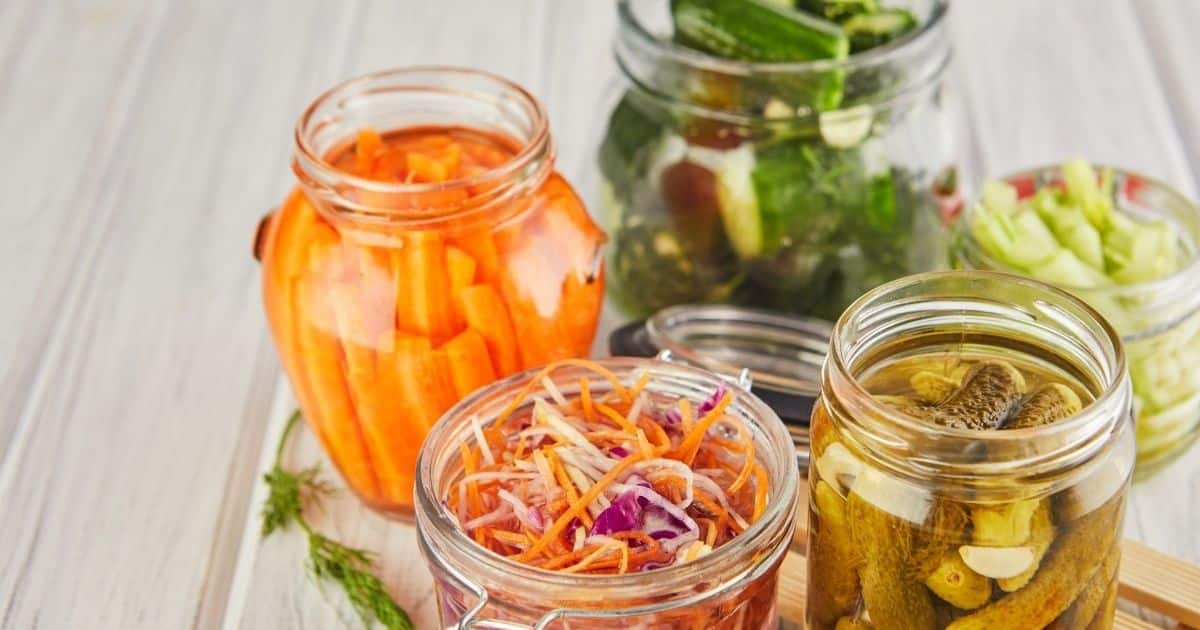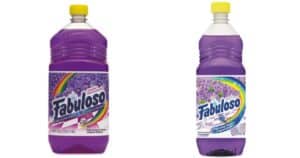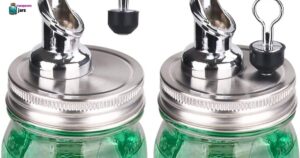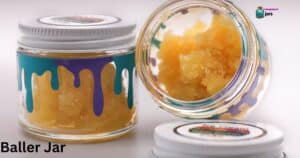Fermenting veggies in a Mason jar is like making flavorful, tangy pickles at home. First, chop your veggies and pack them snugly into the jar. Add a mix of water and salt this kicks off the fermentation magic. Seal the jar and wait patiently as the good bacteria do their job, turning your veggies into tangy goodness.
Gather a Mason jar, chop your favorite veggies, and pack them in. Add water and salt, seal the jar, and wait. The magic happens as good bacteria turn them into tangy goodness. “How to ferment vegetables in a Mason jar?
Fermenting veggies in a Mason jar links tradition with taste. Gather your favorite veggies, slice them up, and pack them tight in a jar. Pour in saltwater, Fresh Juice Last In Mason Jar seal it, and let nature do its thing. It’s like a time-honored method that transforms ordinary veggies into tangy, crunchy delights. Just a few steps and a bit of patience bring a burst of flavor to your table.
Selecting The Right Vegetables For Fermentation
Choosing veggies for fermentation is key. Pick fresh, crisp ones like cabbage, carrots, or cucumbers. Avoid soft or overripe veggies; they won’t ferment well. Opt for organic if possible, ensuring they’re free of chemicals that can interfere with the fermentation process. Variety’s good to mix and match for a flavorful blend.
Certain veggies work like fermentation champs. Cabbage is a star for sauerkraut, while cucumbers make awesome pickles. Carrots, radishes, and even cauliflower are great contenders too. Go for what you love to eat chances are, they’ll ferment into something you’ll love even more.
Preparing Vegetables For Mason Jar Fermentation
Preparing veggies for Mason jar fermentation is simple. Start by washing your chosen vegetables thoroughly. Then, chop them into your preferred sizes, slices, sticks, or shreds all work well. Next, pack the veggies tightly into your clean Mason jar, leaving a bit of space at the top. Don’t forget to add some flavor boosters like garlic, herbs, or spices for that extra zing.
| Preparation Step | Description |
| Wash | Thoroughly rinse vegetables under cold water. |
| Trim | Trim off any stems, ends, or blemishes from veggies. |
| Cut or Slice | Chop, slice, or dice vegetables into desired sizes. |
| Brine or Salt Rub | Apply salt or soak veggies in brine for crispness. |
| Add Flavorings | Add spices, herbs, or aromatics for enhanced taste. |
Creating The Ideal Fermentation Environment In A Mason Jar
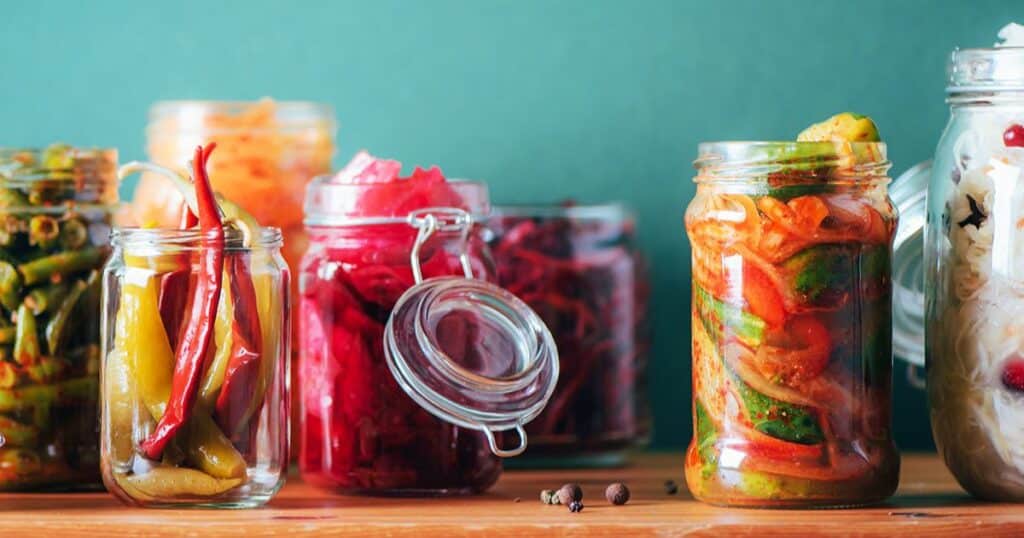
Creating the perfect fermentation home in your Mason jar is simple. Start by ensuring everything’s squeaky clean the jar, your hands, and utensils. Next, pack those chopped veggies tightly; leave minimal air gaps for the magic to happen. Then, mix salt with water and a little salty bath for your veggies. Seal the jar but not too tight; those good bacteria need air to thrive.
Now, find a cozy spot for your jar to hang out. Room temperature is their jam; they’ll ferment happily there. Just avoid direct sunlight, it’s not their thing. In a few days, taste the transformation as those veggies turn tangy and delightful in a perfect environment in a simple Mason jar.
Adding Flavor Enhancements And Seasonings
Enhancing flavors in your fermented veggies is simple. Grab your favorite spices, like garlic, dill, or ginger. Sprinkle them into the jar before sealing it. These additions infuse your veggies with extra zing and character during fermentation. Experiment with different combinations to find your perfect flavor blend.
Seasonings play a crucial role in making your veggies pop. Salt is your fermenting buddy; it not only adds taste but also keeps the bad bacteria away. Other seasonings like peppercorns or chili flakes bring heat and depth to the mix.
Understanding The Fermentation Process Step-By-Step
Sure, understanding fermentation steps is like following a recipe for tangy goodness. Pick your veggies and chop them into pieces. Then, pack them snugly into a clean jar. Mix water and salt, pour it over the veggies until they’re submerged. Seal the jar tightly, and let nature take over.
Now, patience is key. Keep the jar at room temperature, away from direct sunlight. The good bacteria start working their magic! You might see bubbles or notice a tangy smell signs that fermentation’s happening. After a few days or weeks, taste your veggies.
Monitoring Fermentation Progress And Signs Of Success
To track fermentation, peek into your jar daily. Look for tiny bubbles or dizziness. It means the good bacteria are working. A whiff might reveal a tangy aroma, a sign of things changing inside. Keep an eye on the veggies color shifts hint at progress.
They’re pretty obvious! Tanginess intensifies as time passes, and the veggies soften slightly. Don’t fret if you see bubbles or even a cloudy liquid, it’s all part of the fermentation dance. Trust your senses; they’ll guide you to that perfect tangy goodness.
Troubleshooting Common Fermentation Issues
Sometimes, fermentation hits a snag. If you spot mold, scoop it out and discard the affected part. Make sure your veggies are fully submerged to avoid air contact. If things smell funky, it might be due to improper sealing or bad bacteria.
It’s often a sign that fermentation’s working its magic. But if it smells off or slimy, that’s a sign of spoilage. Best to toss it out and start fresh next time. Sometimes, veggies peek above the brine, just give them a gentle push back under.
Safety Measures And Hygiene In Mason Jar Fermentation
Sure, ensuring safety and hygiene when fermenting in Mason jars is crucial. Start by cleaning your jars thoroughly with hot, soapy water and rinse them well. Make sure your hands and all utensils are clean too.
When fermenting, ensure that the vegetables are fully submerged in the brine to prevent mold growth. Keep the jar away from direct sunlight and at a stable room temperature.
Experimenting With Different Vegetable Combinations
Mixing veggies in fermentation is like creating flavor symphonies. Try carrots with radishes or cabbage with peppers. Chop them up, toss them together, and pack them snugly into a jar. The magic begins as they blend their tastes during fermentation. Experimenting opens a world of tangy possibilities, creating unique flavors that surprise your taste buds.
Playing with various veggie combos is simple and exciting. Blend cauliflower with carrots or add some garlic to your usual mix. The key is to explore different textures and tastes. Pack them in jars, add the brine, and watch the flavors meld during fermentation. It’s a flavorful journey that might lead to your own secret recipe.
Storing And Enjoying Fermented Vegetables From Mason Jars
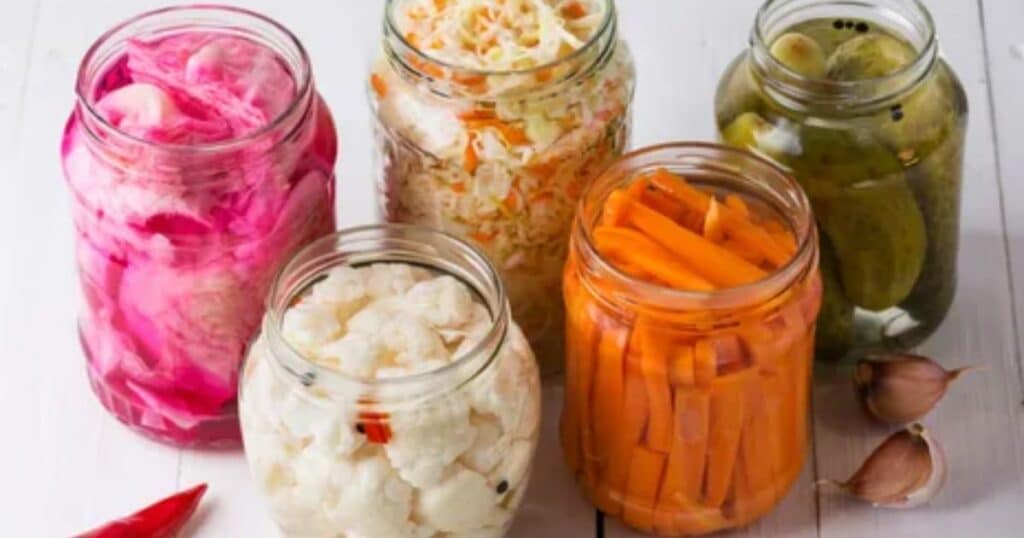
Once your veggies are fermented, storing them is a breeze. Just seal those Mason jars tight and pop them into the fridge. Cold temperatures slow down the fermentation, keeping those flavors crisp and tangy. When it’s time to enjoy, scoop out your pickled treasures and add them to sandwiches, salads, or enjoy them as a zesty snack straight from the jar.
Experiment with various combinations and flavors. Mix and match veggies, herbs, and spices to create your Ferment Vegetables In A Mason Jar. Don’t be afraid to try different fermenting times, some like it tangier while others prefer a milder taste. With each batch, you’ll discover your own perfect blend, making every jar a delightful surprise.
Frequently Asked Questions
Can you ferment in a normal mason jar?
These jars work like magic for fermenting veggies. They create the perfect environment for good bacteria to thrive.
What size jar is best for fermentation?
Choosing the right jar size for fermenting is key. A larger jar, like a quart-sized one, works well for bigger batches of veggies.
How do you clean mason jars before fermentation?
Cleaning mason jars before fermenting is crucial for success. Start by washing the jars, lids, and rings in hot, soapy water.
Conclusion
Fermenting vegetables in a Mason jar is a simple, rewarding process. With basic steps like chopping, packing, and sealing, you’re on your way. Patience is key as the bacteria work their magic, transforming veggies into tangy delights.
Once your jars are set up, periodic “burping” releases built-up gases, ensuring a smooth process. Enjoy experimenting with various vegetables and flavors to create your signature tangy treats. Homemade fermented veggies from a Mason jar add a zing to meals, offering a healthy, probiotic-rich punch. With these steps, anyone can savor the joys of homemade fermentation.

